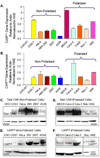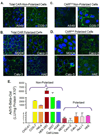Adenovirus transduction: More complicated than receptor expression
- PMID: 28049062
- PMCID: PMC5276731
- DOI: 10.1016/j.virol.2016.12.020
Adenovirus transduction: More complicated than receptor expression
Abstract
The abundance and accessibility of a primary virus receptor are critical factors that impact the susceptibility of a host cell to virus infection. The Coxsackievirus and adenovirus receptor (CAR) has two transmembrane isoforms that occur due to alternative splicing and differ in localization and function in polarized epithelia. To determine the relevance of isoform-specific expression across cell types, the abundance and localization of both isoforms were determined in ten common cell lines, and correlated with susceptibility to adenovirus transduction relative to polarized primary human airway epithelia. Data show that the gene and protein expression for each isoform of CAR varies significantly between cell lines and polarization, as indicated by high transepithelial resistance, is inversely related to adenovirus transduction. In summary, the variability of polarity and isoform-specific expression among model cells are critical parameters that must be considered when evaluating the clinical relevance of potential adenovirus-mediated gene therapy and anti-adenovirus strategies.
Keywords: Adenovirus; Apical and basolateral; Coxsackievirus and adenovirus receptor (CAR); Epithelia; Non-polarized; Polarized; Tight junction.
Copyright © 2016 Elsevier Inc. All rights reserved.
Figures



References
-
- Bergelson JM, Cunningham JA, Droguett G, Kurt-Jones EA, Krithivas A, Hong JS, Horwitz MS, Crowell RL, Finberg RW. Isolation of a common receptor for Coxsackie B viruses and adenoviruses 2 and 5. Science. 1997;275:1320–1323. - PubMed
-
- Carson SD, Chapman NN, Tracy SM. Purification of the putative coxsackievirus B receptor from HeLa cells. Biochem Biophys Res Commun. 1997;233:325–328. - PubMed
-
- Carvajal-Gonzalez JM, Gravotta D, Mattera R, Diaz F, Perez Bay A, Roman AC, Schreiner RP, Thuenauer R, Bonifacino JS, Rodriguez-Boulan E. Basolateral sorting of the coxsackie and adenovirus receptor through interaction of a canonical YXXPhi motif with the clathrin adaptors AP-1A and AP-1B. Proc Natl Acad Sci U S A. 2012;109:3820–3825. - PMC - PubMed
Publication types
MeSH terms
Substances
Grants and funding
LinkOut - more resources
Full Text Sources
Other Literature Sources

